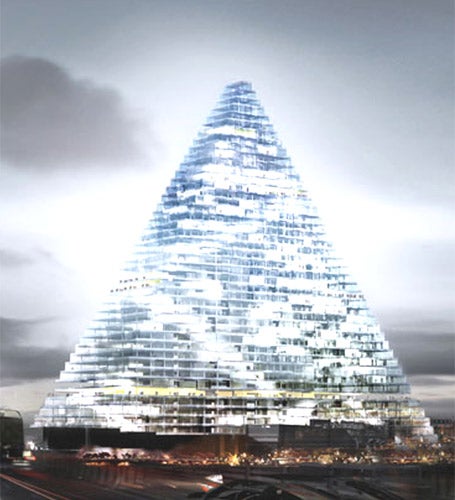Triangle may beat Paris skyscraper ban
Modernist block would be first in 20 years to break 37m height limit

Your support helps us to tell the story
From reproductive rights to climate change to Big Tech, The Independent is on the ground when the story is developing. Whether it's investigating the financials of Elon Musk's pro-Trump PAC or producing our latest documentary, 'The A Word', which shines a light on the American women fighting for reproductive rights, we know how important it is to parse out the facts from the messaging.
At such a critical moment in US history, we need reporters on the ground. Your donation allows us to keep sending journalists to speak to both sides of the story.
The Independent is trusted by Americans across the entire political spectrum. And unlike many other quality news outlets, we choose not to lock Americans out of our reporting and analysis with paywalls. We believe quality journalism should be available to everyone, paid for by those who can afford it.
Your support makes all the difference.The dainty pyramid outside the Louvre museum in Paris looks set to gain a giant sister. Towering at a height of 180m, the new pyramid, known as Projet Triangle, will be nine times the size of the edifice that greets visitors to the main courtyard of the Palais du Louvre.
With 50 storeys and 88,000 square metres of office space, the glass and metal structure designed by the Swiss architects Jacques Herzog and Pierre de Meuron might be seen as Paris's answer to Lord Foster's Swiss Re building in the City of London, known affectionately as the Gherkin.
No skyscraper has been built in the French capital for almost 20 years, but today officials will vote on a modification to planning regulations that would enable the Triangle to be built at the Porte de Versailles, just inside the city's south-western walls.
Last summer, the Socialist Mayor of Paris, Bertrand Delanoë, launched a controversial proposal to overturn a ban on high-rise buildings in a city where the Tour Montparnasse is a much-bemoaned blight on the skyline. The Triangle would be the first of six new skyscrapers to break the maximum 37m height limit on buildings.
However, Denis Baupin, the Deputy Mayor and a member of the Green Party, has criticised the proposals as "bling-bling architecture". He said: "We have already got one tower that adds to the city's radiance: the Eiffel Tower. No need for another one."
As the design has evolved, the Triangle – which would become the third-tallest structure in Paris after the Eiffel and Montparnasse towers – has gained more detractors.
The original plan to incorporate a 400-bedroom hotel was scrapped in favour of extra office space. A single panoramic lift on the north face will take visitors up to the top of the tower, as opposed to the multiple elevators that were first put forward.
Philippe Goujon, a senior official of the ruling UMP party in the Vaugirard district, or 15th arrondissement, where the Triangle will be built, said: "Now it is a simple office project with nothing very original to see."
But one of Mr Delanoë's lieutenants, Anna Hidalgo, said: "Five thousand jobs will be created and visitors will be able to go up the tower and look out over Paris. And there will be a new 8,000-metre public garden."
The 20-metre-high Louvre pyramid was almost as controversial when built in 1989. Many people felt the futuristic creation of the Chinese-born US architect Ieoh Ming Pei clashed with the palace. It has also been the subject of urban Satanic legend; some people claimed it had 666 panes of glass – a myth repeated in Dan Brown's novel The Da Vinci Code – but it has 673.
After the vote on the Triangle, it will be the subject of a public inquiry next year. If all goes smoothly, the owner Unibail-Rodamco hopes to have it completed in 2013.
Join our commenting forum
Join thought-provoking conversations, follow other Independent readers and see their replies
Comments